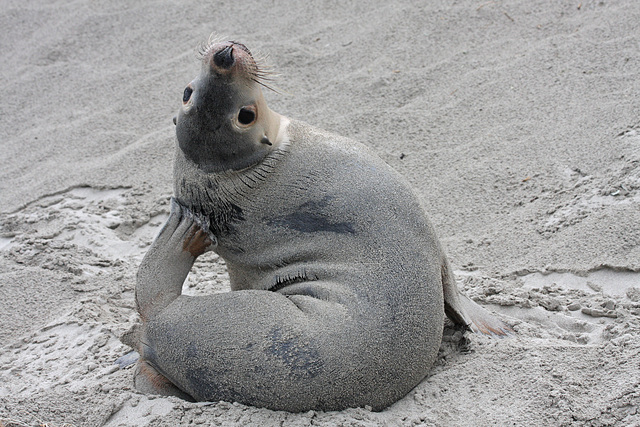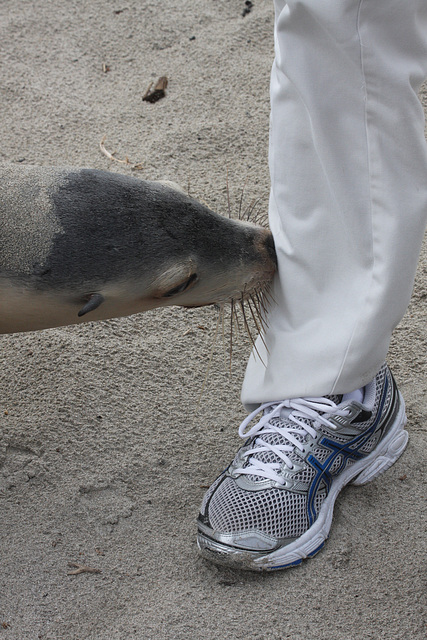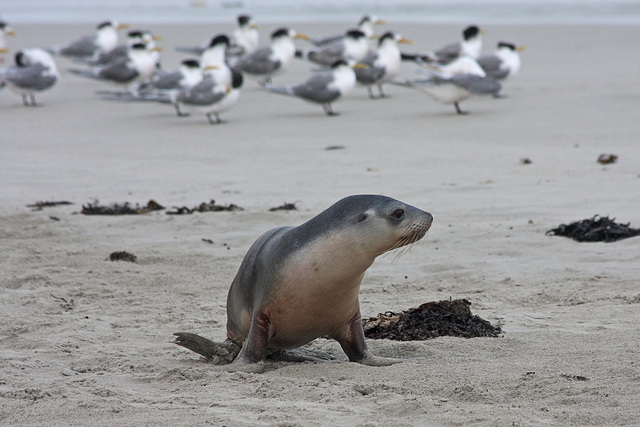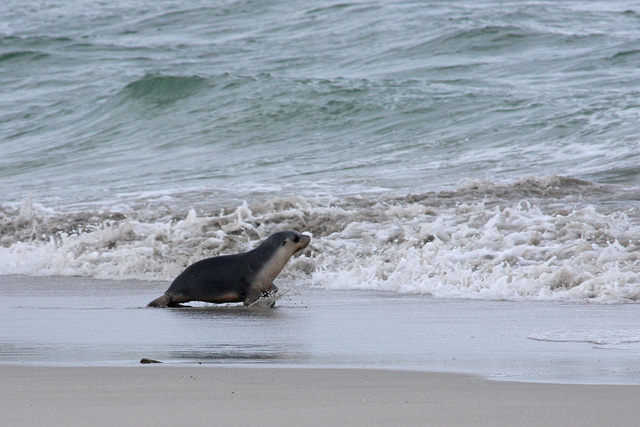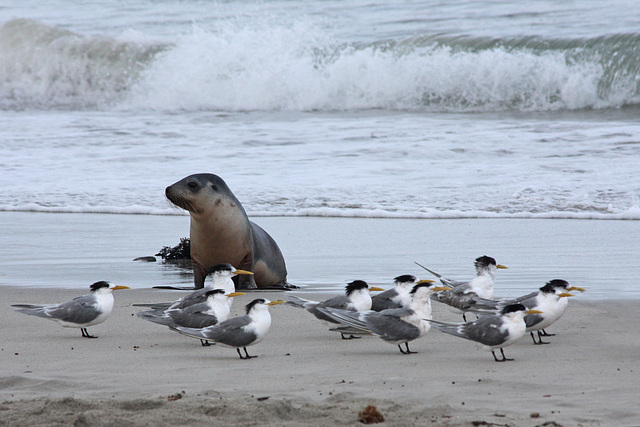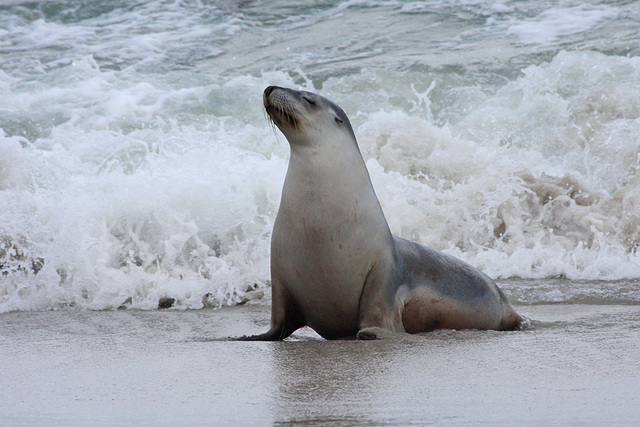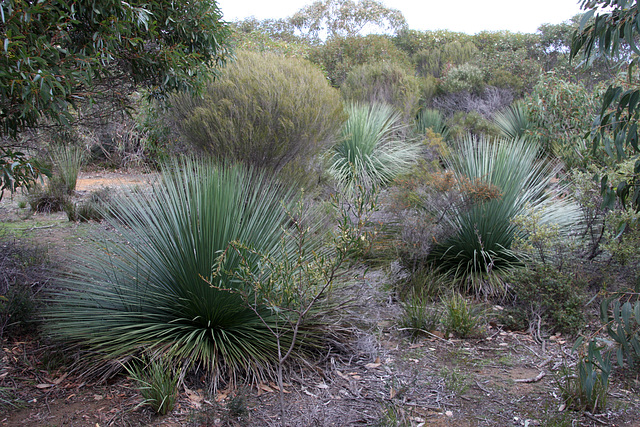
Australia
Because I can!
Australian Sea Lion - Kangaroo Island, Australia
Sea lions differ from seals in a number of ways. They have ear flaps instead of ear holes and they can walk on land by rotating their hind flippers forward and underneath their bodies.
Approximately 15,000 Australian Sea Lions inhabit the southern and western coast of Australia. This sea lion is part of a colony who live on Seal Bay in Kangaroo Island.
Kangaroo Island is the third largest island in Australia after Tasmania and Melville Island. Less that 4,600 people inhabit the island. The island is known for its natural beauty and wildlife.
AIMG_6376
Smelly socks
Australian Sea Lion - Kangaroo Island, Australia
While strolling with others on a beach on Kangaroo Island in Australia, we were approached by a curious young sea lion that had just swum ashore. We stood still and let the sea lion approach. He came right up to my husband, took a sniff and then scampered off. I only had my telephoto lens with me and I was unable to capture the full scene. However, the shot that I did take is probably more interesting and certainly more amusing than the one that I would have taken had I had a smaller lens on the camera.
Other captions that were considered were "You know that it's time to change your socks when they attract sea lions" and "Sure smells like fish."
Sea lions differ from seals in a number of ways. They have ear flaps instead of ear holes and they can walk on land by rotating their hind flippers forward and underneath their bodies.
Approximately 15,000 Australian Sea Lions inhabit the southern and western coast of Australia. This sea lion is part of a colony who live on Seal Bay in Kangaroo Island.
Kangaroo Island is the third largest island in Australia after Tasmania and Melville Island. Less that 4,600 people inhabit the island. The island is known for its natural beauty and wildlife.
AIMG_6369
Racing up the beach
Australian Sea Lion - Kangaroo Island, Australia
Sea lions differ from seals in a number of ways. They have ear flaps instead of ear holes and they can walk on land by rotating their hind flippers forward and underneath their bodies.
Approximately 15,000 Australian Sea Lions inhabit the southern and western coast of Australia. This sea lion is part of a colony who live on Seal Bay in Kangaroo Island.
Kangaroo Island is the third largest island in Australia after Tasmania and Melville Island. Less that 4,600 people inhabit the island. The island is known for its natural beauty and wildlife.
AIMG_6372
Past the obstacles
The young sea lion has made it past the crested terns but still keeps an eye on them.
Sea lions differ from seals in a number of ways. They have ear flaps instead of ear holes and they can walk on land by rotating their hind flippers forward and underneath their bodies.
Approximately 15,000 Australian Sea Lions inhabit the southern and western coast of Australia. This sea lion is part of a colony who live on Seal Bay in Kangaroo Island.
Kangaroo Island is the third largest island in Australia after Tasmania and Melville Island. Less that 4,600 people inhabit the island. The island is known for its natural beauty and wildlife.
AIMG_6390
Racing the waves
Australian Sea Lion - Kangaroo Island, Australia
Sea lions differ from seals in a number of ways. They have ear flaps instead of ear holes and they can walk on land by rotating their hind flippers forward and underneath their bodies.
Approximately 15,000 Australian Sea Lions inhabit the southern and western coast of Australia. This sea lion is part of a colony who live on Seal Bay in Kangaroo Island.
Kangaroo Island is the third largest island in Australia after Tasmania and Melville Island. Less that 4,600 people inhabit the island. The island is known for its natural beauty and wildlife.
AIMG_6384
A wary eye
This young sea lion eyes the flock of crested terns before deciding to go around them rather than through them.
Sea lions differ from seals in a number of ways. They have ear flaps instead of ear holes and they can walk on land by rotating their hind flippers forward and underneath their bodies.
Approximately 15,000 Australian Sea Lions inhabit the southern and western coast of Australia. This sea lion is part of a colony who live on Seal Bay in Kangaroo Island.
Kangaroo Island is the third largest island in Australia after Tasmania and Melville Island. Less that 4,600 people inhabit the island. The island is known for its natural beauty and wildlife.
AIMG_6386
Baby face
Young Australian Sea Lion - Kangaroo Island, Australia
Sea lions differ from seals in a number of ways. They have ear flaps instead of ear holes and they can walk on land by rotating their hind flippers forward and underneath their bodies.
Approximately 15,000 Australian Sea Lions inhabit the southern and western coast of Australia. This sea lion is part of a colony who live on Seal Bay in Kangaroo Island.
Kangaroo Island is the third largest island in Australia after Tasmania and Melville Island. Less that 4,600 people inhabit the island. The island is known for its natural beauty and wildlife.
AIMG_6393
Ahhhh! Feeling good
Australian Sea Lion - Kangaroo Island, Australia
Sea lions differ from seals in a number of ways. They have ear flaps instead of ear holes and they can walk on land by rotating their hind flippers forward and underneath their bodies.
Approximately 15,000 Australian Sea Lions inhabit the southern and western coast of Australia. This sea lion is part of a colony who live on Seal Bay in Kangaroo Island.
Kangaroo Island is the third largest island in Australia after Tasmania and Melville Island. Less that 4,600 people inhabit the island. The island is known for its natural beauty and wildlife.
AIMG_6395
Young trees
Tate's Grass Tree (Yacca), Kangaroo Island, Australia.
Xanthorrhoea is a genus of flowering plants native to Australia. There are
28 species and five subspecies of Xanthorrhoea. They are commonly known
as Grass Trees or Yacca (in South Australia). All are perennials and many,
but not all species develop an above ground stem. This is rough-surfaced,
built from accumulated leaf-bases around the secondarily thickened trunk.
The trunk is sometimes unbranched, some species will branch if the growing
point is damaged and others naturally grow numerous branches.
It is commonly believed that the Xanthorrhoea grow at a rate of about 25
mm per century. They do grow very slowly, but this is a gross underestimate.
After an initial establishment phase the average rate of growth varies
for each species but can be as high as about 25 mm per year. Thus a five
metre tall member of one of the fastest growing Xanthorrhoea would be
about 200 years old. A slow one may be some 600 years old.
woodgroupsa.org.au/wSAknowledge/grasses.pdf
AIMG_6410
Jump to top
RSS feed- Latest items - Subscribe to the latest items added to this album
- ipernity © 2007-2024
- Help & Contact
|
Club news
|
About ipernity
|
History |
ipernity Club & Prices |
Guide of good conduct
Donate | Group guidelines | Privacy policy | Terms of use | Statutes | In memoria -
Facebook
Twitter

